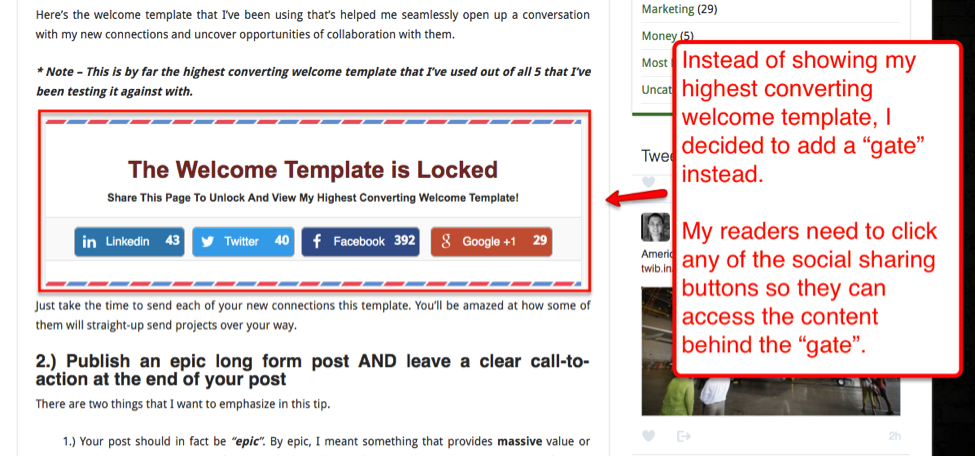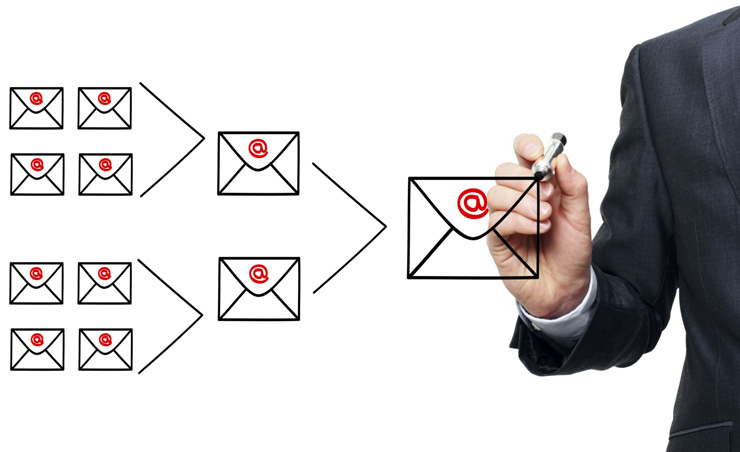What if I told you that there is a way to turn your $1 into $44.25? That got you thinking, huh? Of course, I’m not talking about gambling or any kind of shady make-money online schemes that’s going to ruin your reputation. I’m talking about a marketing strategy that’s totally legit, and is something that’s been used by business owners and marketers for ages. Heck, you’re probably even using this marketing method right now. Which marketing method am I talking about, though? Email marketing, of course. According to Emailexpert.org, for every $1 spent on email marketing, the average return you’ll get from your investment is $44.25. Pretty amazing, isn’t it? With that kind of return, we’d all be touched in the head if we didn’t strive to build our email list from day one. Here’s what we’ll do. Since you’re into finding ways to multiply your money (just like I am), then allow me to share with you some strategies that you can use to grow your email list.
With the kind of potential email marketing has when it comes to multiplying your money, growing your email list will surely pay you in dividends down the road as you run your business.
Let’s hop right in.
1. Offer free case studies.
In the sea of mediocre content that internet users have to plow through daily, you’ll be a breath of fresh air if you start throwing value-packed case studies their way. Why, you might ask? That’s simple. Just like you and I, your readers are also busy. They would rather find all the information that they need in one place, rather than scouring the web for 3 – 5 other resources. Case studies can help your readers with just that — and they know it.
That’s why some of them won’t even think twice about giving away their email addresses, just so they can gain access to your case studies and get all the information that they need in one place.
2. Run contests.
This strategy is pretty cut and dry. All you need to do is to run a contest online, make signing up using your audience’s email as a requirement so they can join, and you’re pretty much good to go.
A word of caution, though. If you want your contest to be a success, you need to put these points into consideration: a) your prize should be worth it, b) your contests’ mechanics should be clear, c) joining your contest shouldn’t be too much of a mission for your audience, and d) you need to actively (and strategically) market your contest.
3. Interview influencers through your podcasts, then share downloadable giveaways.
One of the best ways to get new listeners to your podcasts is to feature other influencers. Simply because they usually have their own group of followers who take the time to consume their content — and the expert ideas that they share are such a goldmine. Now I know that this guide isn’t about getting new listeners to your podcasts, and that’s not really what I am trying to point out.
Featuring influencers in your podcasts is just the first step of the the strategy. The second step — and this is how you’ll grow your email list — is to tell the listeners that you have a downloadable giveaway that’s UBER useful that you’d like to share with them. Of course, before they can download your giveaway, they’d need to enter their email addresses.
Considering how your email capture system is put in front of the influencers’ followers — which usually numbers by the thousands — I’m sure you realize how this one strategy can easily skyrocket your email list.
4. Use gated content.
Instead of explaining what a gated content is, I’d like to show you how it looks like.

To get past through the “gate” that I added on my example above, I required my audience to click any of the social sharing buttons. In your case, you can require them to enter their email address.
These are some of the things that you need to consider to succeed at using this strategy:
- Make your buildup count. If your buildup before the content gate isn’t compelling enough, your readers won’t bother unlocking the gate.
- Avoid adding too many content gates in one post. While there are no one-size-fits-all rule for this, I’d probably say that adding one “gate” per article should be OK. Adding too many will just annoy your readers.
- Make sure that the specific piece of content that you’ll add a “gate” on is something that’s of immense value to your readers.
5. Run a webinar. Make signing up a requirement for them to join.
Webinars are such powerful tools that you can use to help further your business. Whether you’re looking to sell your products, do a product demo, grow a community, or nurture leads, you can make all of them happen through webinars. Since your goal is to grow your email list, here’s what you can do.
First, you need to uncover problems (frustrating ones at that) that you know your target audience are struggling with. You can do this by visiting forums, and looking for “hot threads”, or you can go to Q&A sites and look for questions with the most upvotes, or engagements. Once you’ve uncovered the problems that your audience are facing, you can then invite them to a webinar where you’ll share with them how to solve their problems.
This makes the theme of your webinar a strong enough pull for your target audience. Consider these points when using this strategy:
- The problem you’ll tackle on your webinar must be something that your audience feels strongly about. If it isn’t “cringe-worthy”, the chances are good that they’ll just ignore your webinar.
- Know your audience. If you feel that your audience aren’t that literate when it comes to using the internet (or computer), be sure to reassure them of how easy it is to join your webinar.
- You can add a giveaway at the end of your session. This can help strengthen your audience’s urge to join your webinar.
6. Add a call-to-action at the end of your content.
For the most part, you should be telling your audience the things that you expect them to do after they consume your content every single time. And since we’re into growing your email list, you can ask them (nicely) to sign up to your newsletter, or have them download your freebies by entering their email address in your email capture form.
While you can sprinkle your CTAs on the different parts of your content, I urge you to always add one at the end of your content. Also, avoid adding different types of CTAs. You can ask them to enter their email address in your sign-up form several times within the article (for as long as it makes sense), but avoid asking them to sign up, share, comment, and buy your product, all in a single article.
Adding multiple types of CTAs in one article can be downright annoying to your audience. Or, they might end up experiencing analysis paralysis.
7. Offer free product trials in exchange for your audience’s email addresses.
There are two important points at the core of this strategy:
- Your product needs to be a real problem solver; otherwise, your audience won’t even care about testing it even if it’s for free.
- You need to target the right audience. The thing is, even if your product is amazing, the people to whom you’d market it to won’t be able to appreciate its value if it has nothing to do with them. Imagine sharing your keyword research software product, to an audience of carpenters whose main problems are how to sharpen their saws. On this scenario, even if your product is the best keyword research tool ever made, the carpenters won’t be able to appreciate it.
When you have these points laid down, you’d have a better chance of succeeding when using this strategy.
8. Give discount coupons in exchange for emails.
According to Retailmenot.com, “96% of Americans are coupon users.”
Pretty amazing, huh?
What this tells us is that we can use coupons as a strong-enough pull to influence our audience to take action on things like buying our products, or signing up on our monthly newsletters. So why don’t we do just that? If you aren’t using discount coupons to grow your email list, then know that the coupon rabbit hole is definitely something that you must try.
What’s more, considering how coupons are inherently designed to entice people to buy, using this strategy won’t just help you with growing your list, but it can also impact your sales directly.
9. Add CTAs on your YouTube videos.
There are 3 ways that you can add CTAs in your YouTube videos: 1) you can add the CTA on the video’s description, 2) use annotations, and 3) add the CTA within the actual video that you’ll publish. I urge you make use of all 3 methods, instead of just picking one. That way, your CTA becomes highly visible to your readers.
Here’s where most marketers or business owners make a mistake. Instead of sending their YouTube traffic to a high converting landing page that would entice the viewers to sign up using their email addresses, they merely send their YT traffic to their website’s homepage.
While sending traffic to your homepage seems like an “OK” idea, it actually sometimes isn’t. The thing with your homepage is it is a chock-full of distractions. It has links pointing to your “About us” page, “Contact us” page, and your “Services” page (among others). Now compare that to a landing page that’s highly optimized for only one call-to-action, where the entire page’s message is pointing towards your visitors entering their email addresses only.
10. Using FB ads.
Just 4 days ago, I was listening to a podcast where the host talked about how they reduced their FB ad cost by 80%. The host’s name escapes me, but I couldn’t forget how grateful I was after listening to the podcast since the wisdom bombs thrown at that time were mind blowing.
If there’s one thing that I learned, it would be that you can drastically reduce the amount you spend on your ads, if you knew how to tinker with your ad campaigns. With the adjustments that they made, they only ended up spending about $0.28 per ad click, and out of everyone that clicked and landed to their landing page, about 3% – 4.5% entered their email addresses.
I don’t know about you, but considering the kind of returns that we can get from having people sign up to our email list, and how affordable running FB ads can be, it just makes perfect sense for us to go down the FB ad rabbit hole when it comes to growing our email list.
What’s next?
Are there strategies that you’d like to share about how to grow an email list? If you do, then please take the time to share your strategies in the comments section below. Cheers!



